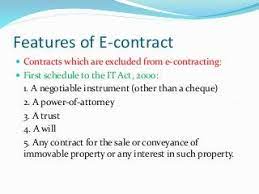E-CONTRACTS / ELECTRONIC CONTRACTS
Electronic Contract refers to a contract that takes place
through e-commerce, often without the parties meeting each other. It
refers to commercial activities transacted electronically. E.g. e-auction,
online purchase through luckonluck.com site, online credit transfer through
bank accounts, payment via payment apps, ATM cash withdrawal, and so on.
Ø
Earlier there were 2
problems with e-transactions and contracts:
1} Writing
/ Recording / Storing the transactions
2)
Recognizable signatures
Ø
Electronic
transactions are:
1)
Cheaper
2)
Easier to perform
3)
Easier to Store
4)
Easier to Retrieve
There are 4 major types of e- contracts:
1.
Browse wrap contracts
2.
Shrink wrap contracts
3.
Click wrap contracts
4.
e-mail contracts
1. Browse Wrap Contract
i.
A browse wrap agreement is
intended to be binding on the contracting party by the use of the website.
ii.
Such contracts are usually used by
websites wherein the continued use of a website by a user is deemed to be
acceptance of its revised terms of use and other policies.
2. Shrink Wrap Contract
i.
A shrink wrap contract is a license
agreement where the terms and conditions of the contract are enforced upon the
consumer as soon as he opens the package.
ii.
Such contracts can be generally
observed in the case of buying of software products. E.g. The license agreement,
indemnity by the user for any copyright or intellectual property rights of the
manufacturer violation, arbitration, limitation of liabilities of the
manufacturer, etc. as soon as the buyer opens the pack (containing the software
product).
3. Click Wrap Contract
i.
Click wrap contract or click through agreements
require the user to manifest his consent or assent to the terms and conditions
governing the licensed usage of the software by clicking "OK" or "I Agree" button
on the dialog box.
ii.
A user may choose to disagree or
reject the terms by clicking cancel or closing the window. Such a user will not
be able to buy or use the service upon rejection.
iii.
Unlike the shrink wrap agreements
where the terms of the agreement are hidden inside the box, in case of click
wrap agreements, all the terms and conditions are accessible prior to
acceptance, either in the same window or through a hyperlink.
4. An email contract has 2 categories:
i.
The contract draft and its signed up
scanned/unscanned copies are exchanged via email OR direct email offer and
email acceptance
ii.
A link is sent via email to the other
party which clicks to verify its acceptance
Status of e-contracts in India
1.
Indian Contract Act
1872 does not exactly and explicitly provide for e-contracts
2.
The Information
technology Act 2000, commonly known as the IT Act governs e-contracts or their
provisions
3.
The IT Amendment Act
gives power to the ventral government on ascertaining as to what mode of
signatures are considerable as electronic signatures
4.
IT Act Amendment in
2008 provided for the validity of contracts formed through electronic means by
bringing in Section 10A stating such contracts cannot become unenforceable merely
as they are in electronic form
5.
The IT Act imposes
regulations on 3 parties to the electronic process transmission:
i.
Originator
ii.
Intermediary
iii.
Addressee
Evidence vis-à-vis E-contracts
i.
Evidence recorded or
stored on electronic devices hold the status of evidence
ii.
Electronic evidence
acceptable as evidence (State of Delhi vs. Mohammad Afzal)
iii.
Voice records taken with
the help of various electronic devices and various modes are treatable as
evidence




Post a Comment